The 21 Circuit Wiring Harness is a comprehensive solution for automotive electrical systems‚ designed for ease of use and versatility. It offers pre-terminated wires‚ color-coded labeling‚ and detailed diagrams‚ making it ideal for both classic and modern vehicle restorations. This harness simplifies complex wiring tasks‚ ensuring reliability and efficiency in managing multiple electrical circuits. Perfect for DIY enthusiasts and professionals alike‚ it provides a robust framework for upgrading or installing vehicle electrical systems.
Overview of the 21 Circuit Wiring Harness
The 21 Circuit Wiring Harness is a versatile and user-friendly electrical system designed for automotive applications. It is ideal for both classic and modern vehicles‚ offering a comprehensive solution for managing up to 21 circuits. This harness features pre-terminated wires‚ color-coded labels‚ and a modular design‚ making it easy to install and customize. It is compatible with a wide range of vehicles and provides a robust framework for powering essential systems like lighting‚ ignition‚ and accessories. The harness includes detailed instructions and wiring diagrams‚ ensuring a smooth installation process. Its universal compatibility and pre-wired connections make it a popular choice for DIY enthusiasts and professionals alike‚ simplifying complex wiring tasks and reducing the need for soldering or advanced tools;
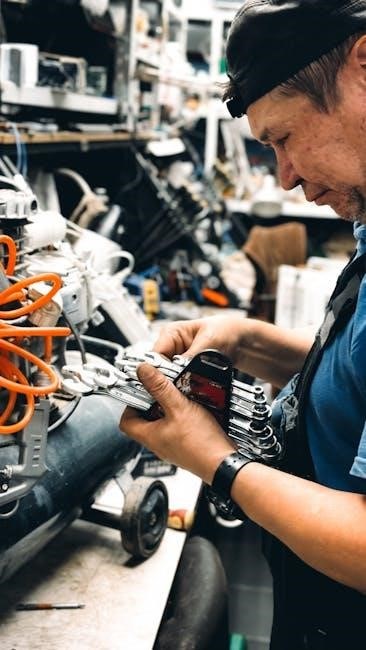
Understanding the 21 Circuit Wiring Harness
The 21 Circuit Wiring Harness is a comprehensive solution for automotive electrical systems‚ offering a modular design and color-coded wires to simplify complex wiring tasks for DIYers and professionals.
Key Components of the Harness
The 21 Circuit Wiring Harness includes pre-terminated wires with color-coded labels for easy identification and connection‚ minimizing errors. A central fuse block distributes power and protects circuits from overcurrent. The wiring diagram offers a clear visual guide for accurate connections. Its modular design provides flexibility‚ accommodating various vehicle setups. These components collectively simplify the wiring process‚ making it accessible for both DIY enthusiasts and professionals. The harness ensures reliability and efficiency in managing a vehicle’s electrical system.
Importance of the Harness in Automotive Electrical Systems
The 21 Circuit Wiring Harness plays a crucial role in modern automotive electrical systems by simplifying the management of multiple circuits. It acts as the central hub‚ ensuring power is distributed efficiently and safely to various vehicle components. This harness minimizes the risk of electrical shortages and ensures all systems function reliably. Its design supports the growing complexity of vehicle electronics‚ making it essential for maintaining performance and safety. By providing a structured and organized wiring solution‚ the harness reduces the likelihood of errors during installation and troubleshooting. It is a cornerstone of modern automotive electrical systems‚ offering durability and adaptability for custom and stock applications alike.

Preparation for Installation
Ensure a large‚ clear work area to spread the harness. Keep the three cable ties near the fuse panel intact. Organize the harness into sections for easier installation.
Tools and Materials Needed
To successfully install the 21 Circuit Wiring Harness‚ you’ll need specific tools and materials. Start with wire strippers‚ crimping tools‚ and screwdrivers for connections. Pliers and a utility knife are essential for wire management. Ensure you have electrical tape and heat shrink tubing for insulation and protection. A multimeter is crucial for testing circuits and identifying issues. Cable ties and clips will help organize the harness neatly. A detailed wiring diagram is indispensable for accurate connections. Lastly‚ a well-lit work area and a large‚ flat surface are necessary for uncoiling and preparing the harness. Having these tools and materials ready will streamline the installation process and ensure a professional result.
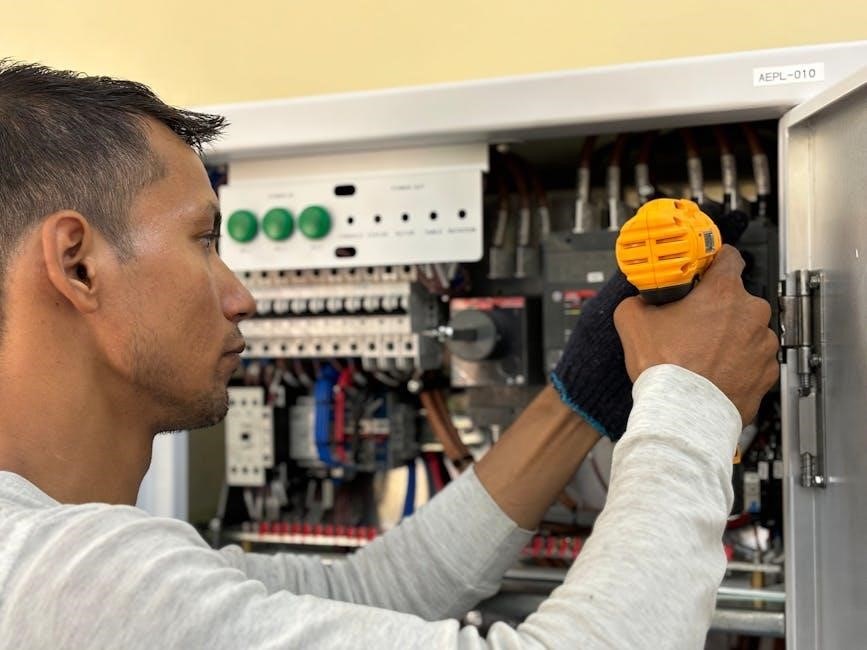
Work Area Setup and Safety Precautions
Setting up a proper work area and following safety precautions is essential for a smooth installation of the 21 Circuit Wiring Harness. Begin by designating a large‚ clean‚ and well-lit workspace to spread out the harness. Ensure the area is free from clutter and flammable materials. Wear protective gear such as gloves and safety goggles to prevent injuries. Before starting‚ disconnect the battery and ground the vehicle to avoid electrical shocks. Keep tools and materials within easy reach to maintain organization. Avoid removing the three cable ties closest to the fuse panel‚ as this can disrupt the harness’s integrity. Use cable ties and clips to secure wires‚ preventing damage or tangling. Proper preparation and adherence to safety guidelines will ensure a safe and successful installation process.
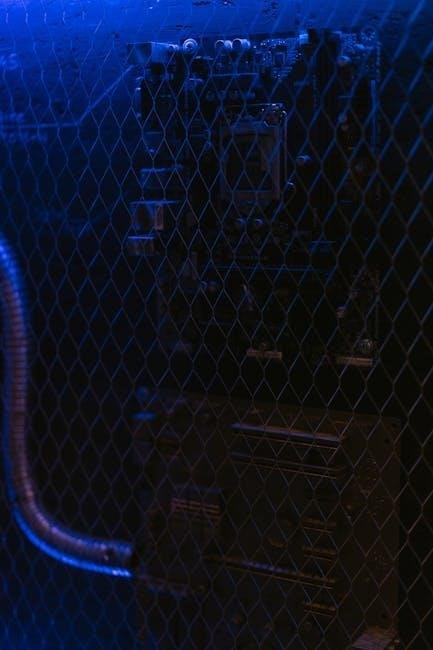
Installation Process
The installation begins with the fuse block‚ organizing wires into sections. Use the wiring diagram for accurate connections. Pre-terminated wires ensure efficiency and a smooth process.
Uncoiling and Organizing the Harness
Begin by carefully uncoiling the 21 circuit wiring harness‚ ensuring no wires are damaged or tangled. Lay it out in a large‚ clear workspace‚ such as the floor near your vehicle. The harness is divided into four coiled sections‚ each secured with cable ties. It’s crucial not to remove the three cable ties closest to the fuse panel‚ as they hold the wiring in place. Start with the largest coil‚ which typically contains the main power and ground wires. Gently unravel each section‚ organizing them into their respective groups based on the wiring diagram. This step ensures a systematic approach‚ preventing confusion and saving time during installation. Proper organization is key to a smooth and efficient wiring process.
Connecting the Fuse Block and Wiring Sections
Start by connecting the fuse block to the main wiring sections‚ ensuring all terminals are securely fastened. Refer to the wiring diagram to identify the correct connections for each circuit. Begin with the largest coil of wires‚ as it typically contains the primary power and ground connections. Carefully route each wiring section to its designated area‚ such as the dashboard‚ lights‚ or accessories. The harness is designed with pre-terminated wires and color-coded labels‚ simplifying the process. Avoid removing the three cable ties near the fuse panel‚ as they maintain the wiring’s structural integrity. Use the provided wiring worksheet to cross-reference connections‚ ensuring accuracy. Properly securing and organizing the wires during this step prevents future issues and ensures reliable electrical performance. Always double-check connections before proceeding to the next section.
Using the Wiring Diagram for Accurate Connections
A wiring diagram is essential for ensuring accurate connections when installing a 21 Circuit Wiring Harness. It provides a detailed visual representation of the entire electrical system‚ showcasing how each wire connects to components like lights‚ accessories‚ and the fuse block. Start by identifying the color-coded wires and their corresponding functions‚ as indicated in the diagram. Cross-reference the wiring sections with the diagram to confirm proper routing and termination points. Pay special attention to the labels on the wires‚ which are printed every 5 inches for clarity. Before making any connections‚ verify that the diagram matches your vehicle’s electrical layout. This step prevents mismatches and ensures all components are powered correctly. Use the diagram to systematically connect each circuit‚ starting from the fuse block and working outward. Always double-check connections against the diagram to avoid errors.
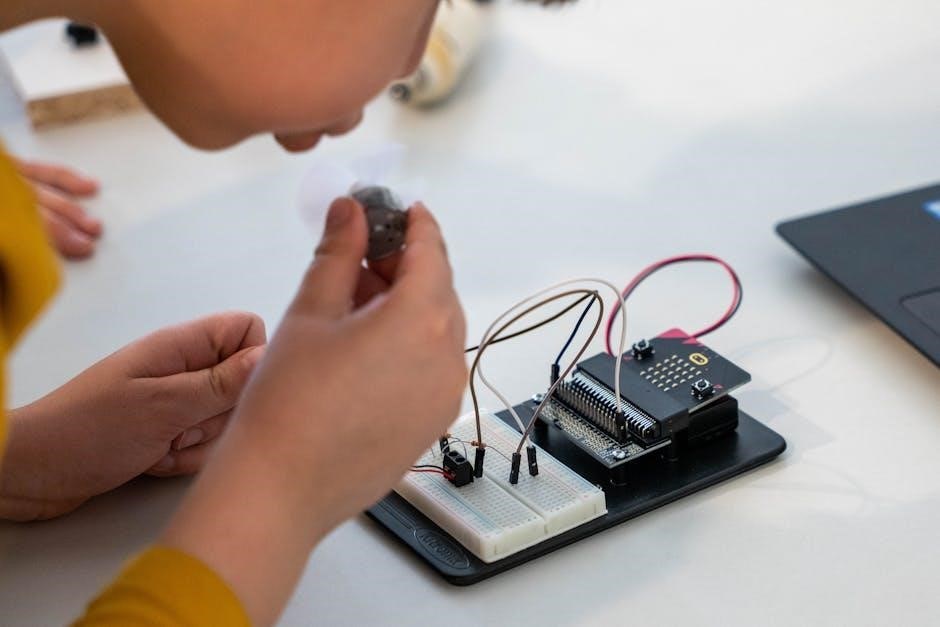
Troubleshooting and Common Issues
Common issues with a 21 Circuit Wiring Harness include short circuits‚ blown fuses‚ and incorrect connections. Always use the wiring diagram to identify and resolve faults efficiently.
Identifying and Fixing Short Circuits
A short circuit in a 21 Circuit Wiring Harness can cause significant issues‚ such as blown fuses or electrical system malfunctions. To identify a short‚ use the wiring diagram to trace affected circuits. Disconnect the battery to ensure safety‚ then inspect wires for visible damage‚ such as cuts‚ burns‚ or exposed copper. Use a multimeter to test for unintended continuity between wires or between a wire and ground. Once the short is located‚ repair or replace the damaged wire‚ ensuring all connections are secure and properly insulated. Regularly inspecting the harness and avoiding overcrowded or poorly routed wires can help prevent short circuits. Always follow safety precautions to avoid further damage or electrical hazards.
Dealing with Faulty Fuses and Wires
Identifying and addressing faulty fuses and wires is crucial for ensuring the reliability of your 21 Circuit Wiring Harness. Start by inspecting the fuse block for blown fuses‚ which may indicate overloaded circuits or short circuits. Replace blown fuses with ones of the correct rating‚ as specified in the wiring diagram. For faulty wires‚ visually inspect for signs of damage‚ such as frays‚ cuts‚ or burn marks. Use a multimeter to test for continuity and identify breaks or unintended connections. When replacing damaged wires‚ ensure they are properly routed and secured to prevent future issues. Always disconnect the battery before working on the harness to avoid electrical shocks or further damage. Regular maintenance and inspections can help prevent fuse and wire failures‚ ensuring optimal performance of your vehicle’s electrical system.
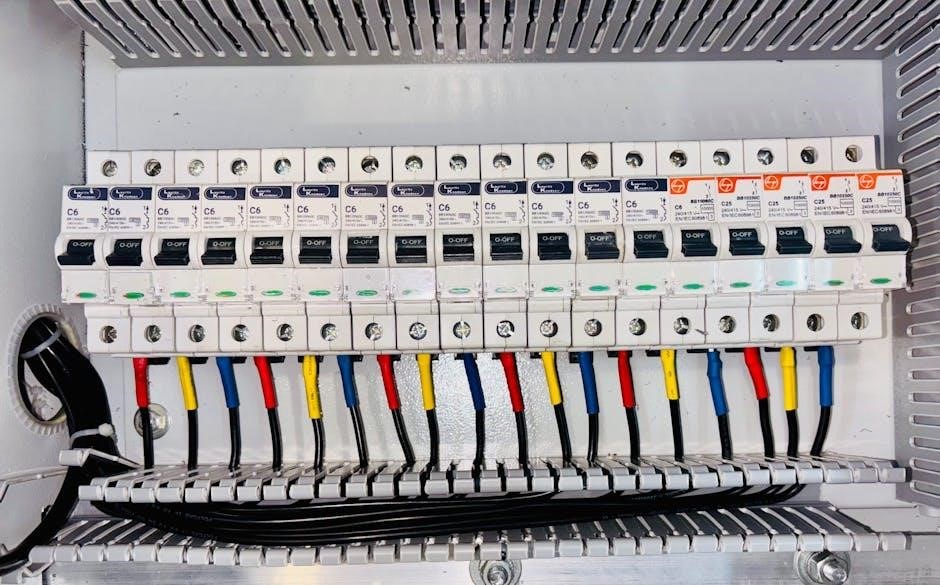
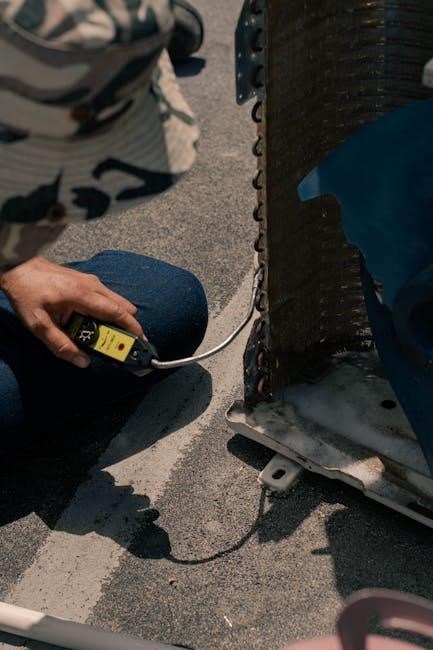
Best Practices for a Successful Installation
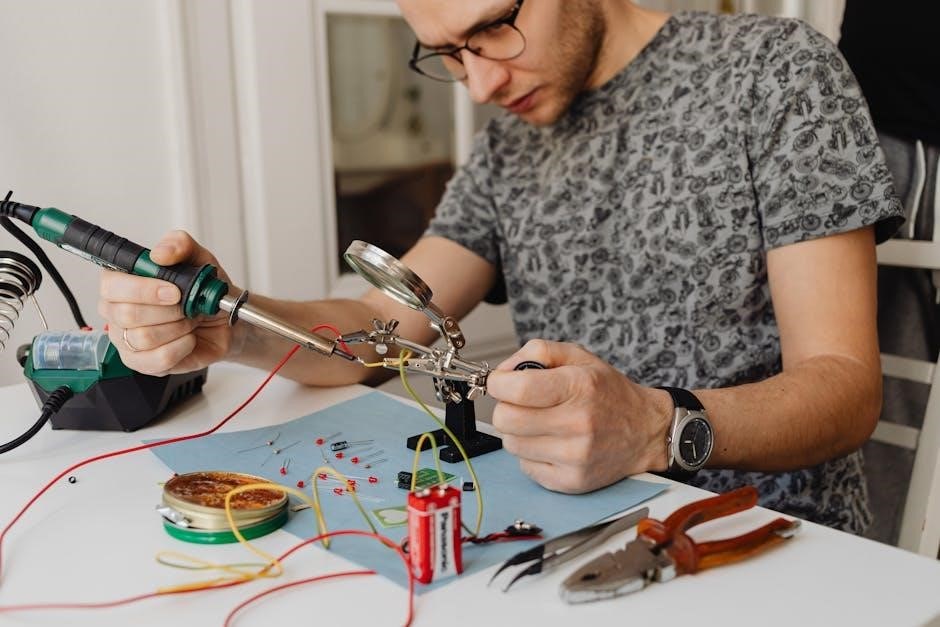
Ensure a clean‚ well-lit workspace and use the provided wiring diagram for accurate connections. Label wires every 5 inches and test the system before finalizing the installation.
Labeling and Organizing Wires
Labeling and organizing wires is essential for a smooth installation process. Begin by labeling each wire at 5-inch intervals using the provided labels and a permanent marker. This ensures easy identification and minimizes confusion. Organize the harness into sections based on their destination or function‚ such as lighting‚ ignition‚ or accessories. Use zip ties to secure wire bundles‚ keeping them tidy and preventing damage. Refer to the wiring diagram to confirm connections and ensure all wires are routed correctly. Proper labeling and organization not only simplify the installation but also make future maintenance easier. Always double-check labels against the diagram to avoid misconnections.
Testing the System Before Finalizing
Testing the system before finalizing the installation is crucial to ensure all components function correctly. Begin by using a multimeter to check for any short circuits or open connections. Turn on each circuit individually‚ such as the headlights‚ taillights‚ and interior lights‚ to verify proper operation. Check the fuse panel to ensure no fuses are blown and that all connections are secure. Consult the wiring diagram to confirm that every wire is connected to the correct terminal. Test the ignition system and accessories to ensure they activate as intended. Proper grounding is essential‚ so verify that all ground wires are securely attached. Finally‚ perform a thorough inspection of the entire harness to identify and address any potential issues before completing the installation.
The 21 Circuit Wiring Harness is a versatile and user-friendly solution for modernizing or upgrading a vehicle’s electrical system. With its modular design‚ pre-terminated wires‚ and color-coded labeling‚ it simplifies even the most complex wiring tasks. Whether you’re a DIY enthusiast or a professional‚ this harness provides a reliable and efficient way to manage multiple circuits. Its compatibility with a wide range of vehicles makes it a valuable tool for both classic restorations and custom projects. Always ensure to follow the instructions carefully and test the system thoroughly before finalizing the installation. By doing so‚ you can enjoy a seamlessly integrated electrical system that powers your vehicle’s functions with precision and reliability. This harness is an excellent choice for anyone looking to enhance their vehicle’s electrical capabilities.